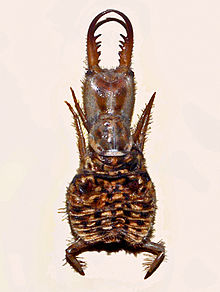
The insect order Neuroptera, or net-winged insects, includes the lacewings, mantidflies, antlions, and their relatives. The order consists of some 6,000 species. Neuroptera is grouped together with the Megaloptera and Raphidioptera (snakeflies) in the unranked taxon Neuropterida.

The antlions are a group of about 2,000 species of insect in the neuropteran family Myrmeleontidae. They are known for the predatory habits of their larvae, which mostly dig pits to trap passing ants or other prey. In North America, the larvae are sometimes referred to as doodlebugs because of the marks they leave in the sand. The adult insects are less well known due to their relatively short lifespans in comparison with the larvae. Adults, sometimes known as antlion lacewings, mostly fly at dusk or just after dark and may be mistakenly identified as dragonflies or damselflies.

Green lacewings are insects in the large family Chrysopidae of the order Neuroptera. There are about 85 genera and 1,300–2,000 species in this widespread group. Members of the genera Chrysopa and Chrysoperla are very common in North America and Europe; they are very similar and many of their species have been moved from one genus to the other time and again, and in the nonscientific literature assignment to Chrysopa and Chrysoperla can rarely be relied upon. Since they are the most familiar neuropterans to many people, they are often simply called "lacewings". Since most of the diversity of Neuroptera are properly referred to as some sort of "lacewing", common lacewings is preferable.

Megaloptera is an order of insects. It contains the alderflies, dobsonflies and fishflies, and there are about 300 known species.

The eastern dobsonfly, Corydalus cornutus, is a large insect in the Corydalidae family. It is found in eastern North America in regions with fast-flowing streams where its aquatic larvae develop. These are known as hellgrammites and are among the top invertebrate predators in the streams in which they live. They are used by anglers as bait.

Euroleon nostras is a species of antlion found over most of Europe. The scientific name can be translated as "our European [ant] lion". Adults resemble dragonflies or damselflies and may reach up to 30 mm (1.2 in) long, with a wingspan of 70 mm (2.8 in). The larvae prey on ants and other small creatures and require dry sandy soil in which to dig their pitfall traps.

The Asilidae are the robber fly family, also called assassin flies. They are powerfully built, bristly flies with a short, stout proboscis enclosing the sharp, sucking hypopharynx. The name "robber flies" reflects their expert predatory habits; they feed mainly or exclusively on other insects and, as a rule, they wait in ambush and catch their prey in flight.

Ascalaphidae is a family of insects in the order Neuroptera, commonly called owlflies; there are some 450 extant species. They are fast-flying crepuscular or diurnal predators of other flying insects, and have large bulging eyes and strongly knobbed antennae. The larvae are ambush predators; some of them make use of self-decoration camouflage.
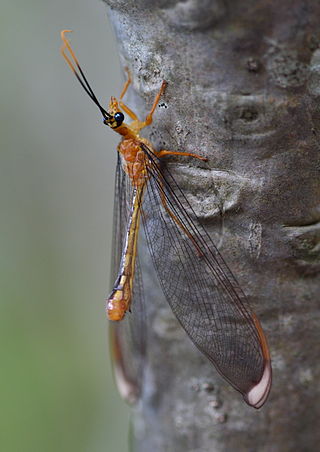
Nymphidae, sometimes called split-footed lacewings, are a family of winged insects of the order Neuroptera. There are 35 extant species native to Australia and New Guinea.

Psychopsidae is a family of winged insects of the order Neuroptera. They are commonly called silky lacewings.

Trichopoda pennipes is a species of feather-legged fly in the dipteran family Tachinidae.

Dendroleon pantherinus is a species of neuropteran insects of the antlion (Myrmeleontidae) family. Larvae are unique among antlions, as they do not create sandy pits, but rather develop in hidden shelters such as hollow trees.

Dermestes ater is a species of beetle in the family Dermestidae, the skin beetles. It is known commonly as the black larder beetle or incinerator beetle. It is native to North America, but today it is found nearly worldwide. Like several other dermestid beetles, this species is a common pest of stored products.
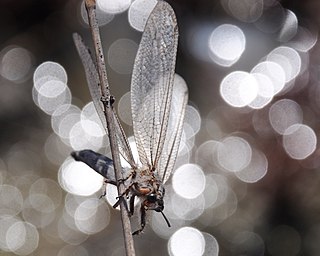
Acanthaclisini is a tribe in the antlion subfamily Myrmeleontinae.
Cordulecerus is a genus of owlflies, neuropteran insects in the subfamily Ascalaphinae. Species are found in Central and South America.
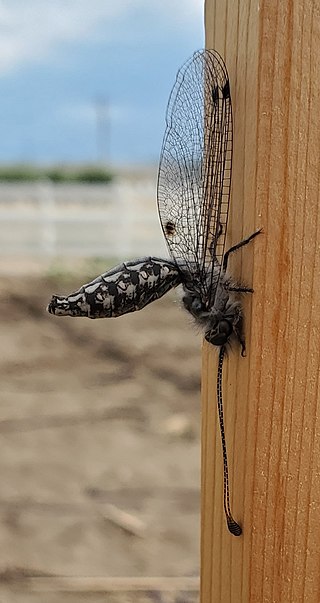
Ululodes is a genus of owlflies in the tribe Ululodini. There are at least 27 described species in Ululodes.

Glenurus is a genus of antlions in the family Myrmeleontidae and typical of the tribe Glenurini. There are about 12 described species in Glenurus.
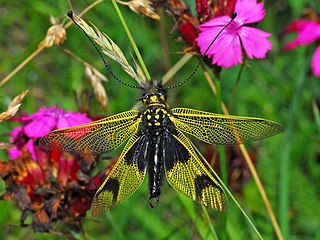
Libelloides longicornis, common name black yellow owlfly, is an owlfly species belonging to the family Ascalaphidae, subfamily Ascalaphinae.
Froggattisca rennerensis is a species of cave-dwelling antlion, endemic to the Northern Territory.
Heoclisis fulva is a species of cave-dwelling antlion, found in Australia, in Queensland, Western Australia and the Northern Territory.

